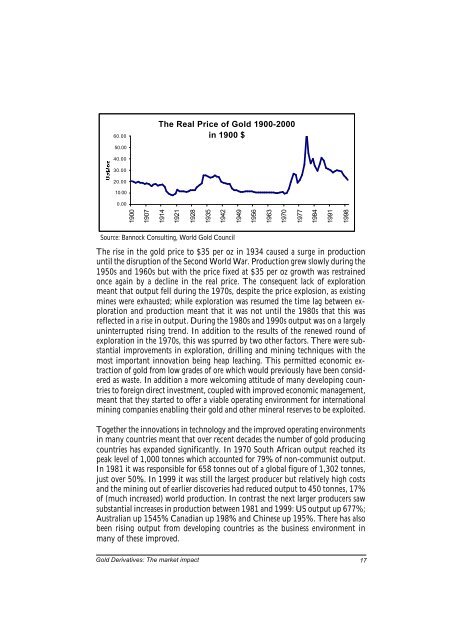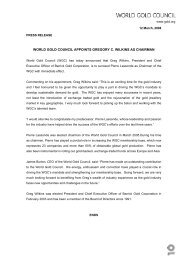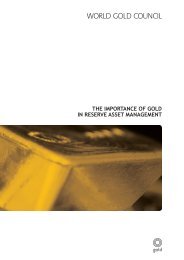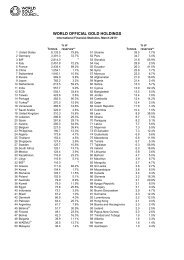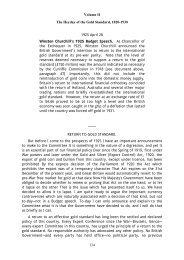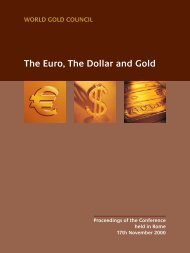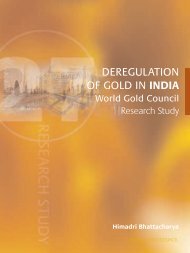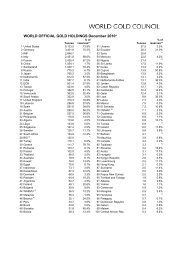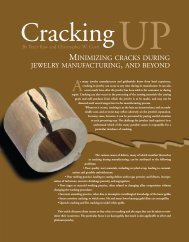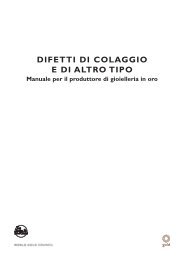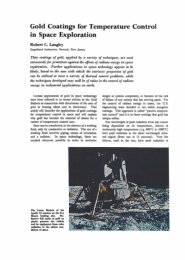Gold Derivatives: Gold Derivatives: - World Gold Council
Gold Derivatives: Gold Derivatives: - World Gold Council
Gold Derivatives: Gold Derivatives: - World Gold Council
You also want an ePaper? Increase the reach of your titles
YUMPU automatically turns print PDFs into web optimized ePapers that Google loves.
60.00<br />
The Real Price of <strong>Gold</strong> 1900-2000<br />
in 1900 $<br />
50.00<br />
40.00<br />
30.00<br />
20.00<br />
10.00<br />
0.00<br />
1900<br />
1907<br />
1914<br />
1921<br />
1928<br />
1935<br />
1942<br />
1949<br />
1956<br />
1963<br />
1970<br />
1977<br />
1984<br />
1991<br />
1998<br />
Source: Bannock Consulting, <strong>World</strong> <strong>Gold</strong> <strong>Council</strong><br />
The rise in the gold price to $35 per oz in 1934 caused a surge in production<br />
until the disruption of the Second <strong>World</strong> War. Production grew slowly during the<br />
1950s and 1960s but with the price fixed at $35 per oz growth was restrained<br />
once again by a decline in the real price. The consequent lack of exploration<br />
meant that output fell during the 1970s, despite the price explosion, as existing<br />
mines were exhausted; while exploration was resumed the time lag between exploration<br />
and production meant that it was not until the 1980s that this was<br />
reflected in a rise in output. During the 1980s and 1990s output was on a largely<br />
uninterrupted rising trend. In addition to the results of the renewed round of<br />
exploration in the 1970s, this was spurred by two other factors. There were substantial<br />
improvements in exploration, drilling and mining techniques with the<br />
most important innovation being heap leaching. This permitted economic extraction<br />
of gold from low grades of ore which would previously have been considered<br />
as waste. In addition a more welcoming attitude of many developing countries<br />
to foreign direct investment, coupled with improved economic management,<br />
meant that they started to offer a viable operating environment for international<br />
mining companies enabling their gold and other mineral reserves to be exploited.<br />
Together the innovations in technology and the improved operating environments<br />
in many countries meant that over recent decades the number of gold producing<br />
countries has expanded significantly. In 1970 South African output reached its<br />
peak level of 1,000 tonnes which accounted for 79% of non-communist output.<br />
In 1981 it was responsible for 658 tonnes out of a global figure of 1,302 tonnes,<br />
just over 50%. In 1999 it was still the largest producer but relatively high costs<br />
and the mining out of earlier discoveries had reduced output to 450 tonnes, 17%<br />
of (much increased) world production. In contrast the next larger producers saw<br />
substantial increases in production between 1981 and 1999: US output up 677%;<br />
Australian up 1545% Canadian up 198% and Chinese up 195%. There has also<br />
been rising output from developing countries as the business environment in<br />
many of these improved.<br />
<strong>Gold</strong> <strong>Derivatives</strong>: The market impact 17


